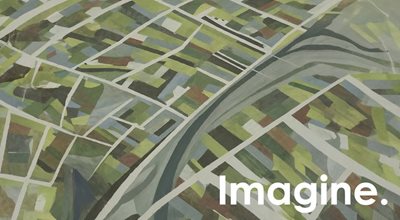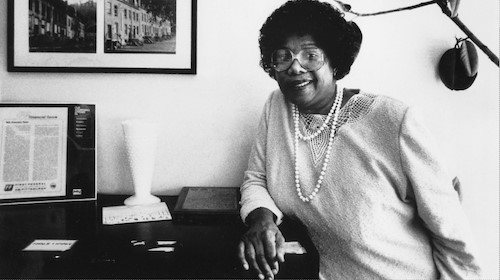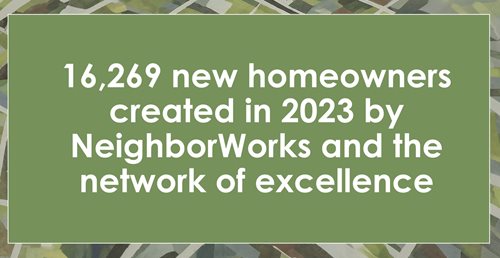Marietta Rodriguez presented this speech at the 2024 National Interagency Community Reinvestment on March 7 as part of a session entitled “A New Landscape for Community Impact.”
Imagine a neighborhood. ANY neighborhood. A neighborhood that you live in, a neighborhood that you grew up in or a neighborhood you've visited.
 Visualize the streets. Visualize the shops. Visualize what the houses look like. Are there yards? Do you see children? Do you hear dogs barking? What do you see in that neighborhood? If you start to visualize that, then think about what's beneath that. Just underneath it, there is an invisible map.
Visualize the streets. Visualize the shops. Visualize what the houses look like. Are there yards? Do you see children? Do you hear dogs barking? What do you see in that neighborhood? If you start to visualize that, then think about what's beneath that. Just underneath it, there is an invisible map.
This map doesn't show trees or bus stops or schools. It reveals a pattern of generational poverty, invisible credit lines that people can't cross, and health problems tied to substandard housing.
It's where you see opportunity gaps in urban, suburban and rural communities. It's where you see struggling city blocks for Native communities that have been long underserved. It is where the racial wealth gap in America exists.
It's not an opinion; it's not a statistic. It's a reality. It's tied to geography.
That invisible map ... that's what I see. And what I'd like you to understand – and to re-envision – for the next 10 minutes.
I see this map every day and at NeighborWorks America, we work hard to erase those invisible lines.
I understand you may be thinking, "What's happening here? This is really going to be depressing." But it's really not. Here's why:
I am in the business – and you are in the business – of changing maps. Of turning those lines of hardship into avenues of opportunity. It's hard. It takes a lot of work. It takes investment. It takes alignment across sectors. But it's happening. Because while others just study problems, NeighborWorks America dives in to form strategies and solutions.
hardship into avenues of opportunity. It's hard. It takes a lot of work. It takes investment. It takes alignment across sectors. But it's happening. Because while others just study problems, NeighborWorks America dives in to form strategies and solutions.
NeighborWorks isn't just about grand ideas. We're about kitchen tables where single parents sign their first mortgages. We're neighborhood meetings where residents, not just city planners, have the floor to talk about the problems in their communities – and come up with solutions.
NeighborWorks gets results because we focus on the heart of communities, and that is people.
So allow me to show you a new way to look at your own community.
We'll go beyond statistics to discover why home isn't just a roof, walls and a kitchen; it's a launchpad. And maybe, just maybe, we'll leave this room as allies, determined to redraw those invisible lines. We'll leave this room aligned with a commitment to make communities better and to make communities stronger. Together.
Origins and successses
Let me share a story. When Dorothy Mae Richardson and her neighbors saw the devastation caused by redlining in an urban Pittsburgh neighborhood, they didn't just see decline – they saw where they needed the tools to fight back.
From that resolve and that frustration, NeighborWorks America was born. Just like those resident leaders, we began out of crisis.
 Then, along came the Community Reinvestment Act. It was not a handout, but a roadmap – a hand up: banks lending where once they hadn't, residents finally given a voice in how to reshape their own blocks. Residents able to access money to invest back into their communities. This origin story of Dorothy Mae Richardson, Pittsburgh, and the Community Reinvestment Act is the DNA that we all share.
Then, along came the Community Reinvestment Act. It was not a handout, but a roadmap – a hand up: banks lending where once they hadn't, residents finally given a voice in how to reshape their own blocks. Residents able to access money to invest back into their communities. This origin story of Dorothy Mae Richardson, Pittsburgh, and the Community Reinvestment Act is the DNA that we all share.
We don't just talk about change; we tackle it and tally it.
Today, nearly 250 NeighborWorks network organizations channel billions annually into housing. And it's housing built right. Housing that is repaired with the community in mind, not just for profit. But we're not a museum to those early successes. Crisis after crisis, we evolved.
We partnered with developers to add affordable units, creating mixed-income development havens. We helped cities manage vacant properties instead of letting them deteriorate. That's what gives us energy. That's what gives us excitement and that's what gives us hope – that we can change communities.
Adapting to serve all communities
It became all too clear that adaptability isn't an afterthought; it's ingrained in our mission. When we saw opportunity gaps – like those in Native communities that have traditionally been underserved – we didn't assign blame.
We saw a chance to be better partners, relearning how to be truly impactful. In 2019 we began by listening – deeply engaging with tribal housing programs, Native Community Development Financial Institutions and national stakeholders.
This led to NeighborWorks America's Native Strategy: Investing intentionally in building respectful partnerships and progressing strategies alongside Native residents themselves. This work required shifting how we operate. Recognizing tribal sovereignty isn't a buzzword – it's how sustainable homeownership models get built.
We've provided partnership grants and hired a full-time Native director to guide our strategy. These were not one-off actions but investments in a more equitable and sustainable future.
It was co-created.
Resident empowerment: Beyond helping
This is another example of true alignment:
Many people living within those invisible lines know that yesterday's progress can't solve all of today's challenges.
It requires a true partnership … the kind we're forging and that has always been part of the NeighborWorks way. It isn't simply about providing solutions. It's about fostering the ability of residents to design their own paths forward, leveraging outside resources long-term for sustainable change.
NeighborWorks way. It isn't simply about providing solutions. It's about fostering the ability of residents to design their own paths forward, leveraging outside resources long-term for sustainable change.
Think of it this way: You can help a person acquire the skills, the credit, and the support network to realize their own dreams and financial future.
That path? That's capacity building. That's not temporary. It changes destinies for generations.
This principle that investment should mean mobilization – it applies across communities. It means distributing grants AND fostering an environment where residents themselves can pave new paths forward.
For Ken Eakes, executive director of the Military Support Foundation, NeighborWorks Achieving Excellence Program transformed his approach to service. This program, in partnership with Harvard University, trains and coaches 50 leaders over two years, helping them address their organization's most critical challenges. Thanks to support from Wells Fargo, NeighborWorks' Achieving Excellence Program includes its first Native cohort. As part of this cohort, Mr. Eakes gained a broader perspective on housing insecurity.
Witnessing the challenges faced by Native communities, he recognized stark parallels with the needs of veterans that his organization serves. This sparked a powerful shift: Mr. Eakes now champions housing solutions across Native communities and actively connects Native veterans with vital homeownership resources. His journey demonstrates the true potential of the program's collaborative approach – unlocking fresh vision and impact that extends well beyond a single organization.
Individual success stories like Mr. Eakes's aren't isolated. NeighborWorks network organizations offer tools across a spectrum: homeownership counseling, post-purchase education – all of this combined makes ownership feasible for those often stuck in a landlord-tenant cycle.
Partnerships that move mountains
Counseling homeowners – that's the foundational work of NeighborWorks America and our network of excellence. But as communities navigate soaring costs to zoning complexities, we know going it alone has its limits. The most transformative progress demands strategic alliances. And sometimes, the most overlooked yet essential partnership is between funding and the homeowner themselves.
NeighborWorks America's LIFT Program, a down payment assistance program supported by Wells Fargo. It's not just about providing financial aid; it's about unlocking potential and fostering future advocates of homeownership.
Mr. Kabayiza, a refugee from Rwanda, found stability and community after purchasing a house with help from a NeighborWorks network organization. Inspired by his experience, he now teaches others in his community about saving and the possibilities of homeownership. In Alaska, first responder Mike and his wife, Carissa, were able to purchase a home thanks to LIFT funds that covered vital repairs. And after renting for decades in Minnesota, Chef Folashade now celebrates the simple joy of a place that's truly her own.
Stories like these illustrate this ripple effect. Having purchased a home with help from NeighborWorks' LIFT program, each person was inspired to become a champion of financial literacy in their community, empowering others to achieve their dream of ownership.
Let me share another example of impactful partnerships. At NeighborWorks, we understand housing is health. But how could we engage health partners like hospitals and community health centers? Again, we had a chance to be better partners, and again, we began by listening and deeply engaging. Then, in partnership with the Center for Community Investment and Capital One, we launched a partner-focused learning lab. Through that learning lab, community-based organizations learned how to have conversations with health providers, speaking in their language to help them understand our field of affordable housing and community development – and how it connected to our shared work around health and racial equity.
This model needs diverse partners, like NeighborWorks America, like local organizations, like financial institutions. We need to collaborate to cultivate long-term success. A long-term commitment to capacity building builds leaders who can manage the next community crisis, the next weather-related crisis, the next pandemic. It's critical that we have seasoned leaders working in communities. This collaborative mindset is core to NeighborWorks' impact, which makes any CRA engagement with us about more than just buildings; it's about community-focused collaborations.
Challenges and hopeful action
We celebrate successes like the ones I've just mentioned, but they still need to balance the scale of need. The lack of truly affordable homes is an ongoing crisis, compounded by rising materials costs, decaying housing stock and often restrictive local zoning. In some cities, it's not just a lack of homes but a lack of the vital services that make neighborhoods function: childcare, reliable transit, and even grocery stores. These hurdles reveal why solutions must be as adaptable as the challenges they address.
For the communities we prioritize, the dream of homeownership feels increasingly unattainable without bold action.
This underscores three essential calls to action:
Investment in Capacity Building: This isn't about a handout, it's about empowering communities to lead. Like our Advancing Leaders in Real Estate Program, we must invest in organizations on the ground, strengthening their expertise and networks. They are the ones who know the local challenges intimately and are best equipped to design solutions that stick. This ensures readiness, not just reaction, during future crises.
Targeted Homeownership Support with a Focus on Equity: Down payment assistance programs like LIFT and Accelerating Homeownership for People of Color play a pivotal role. Without them, the racial wealth gap widens. Funding affordable mortgage programs, creating culturally competent pathways to ownership within financial institutions – these are about more than transactions. They are about reversing decades of systemic inequity. This must be an ongoing commitment, not a one-off gesture.
Investment in Time & Resources Promoting Cross-Sector Partnerships: The pandemic showed us silos don't serve communities. Just as housing impacts health, as exemplified by the work of NeighborWorks network members, lasting progress demands collaboration. We need partners across sectors – banking, healthcare, local leaders – to invest in shared goals that yield transformative, holistic outcomes.
These actions might demand resilience, but it's a resilience born from optimism. Every homeowner we help is a step toward redrawing those invisible lines of hardship. This work matters because homeownership isn't just about having a kitchen, it's about building a legacy, brick by brick.
Recall a chef celebrating the joy of a meal in a kitchen that's finally hers.
Imagine a homeowner armed with knowledge, leading others to homeownership and to a voice in their community's future.
Picture Native communities finally claiming agency over their own housing destinies, building stability on a foundation of respect, not broken promises.
This is NeighborWorks in action. It's about countless acts of empowerment echoing within communities nationwide. I challenge you to join us in this work.
This means:
Invest in the on-the-ground leaders who make change stick.
Fund the programs that close the racial wealth gap, one homeowner at a time.
Commit to the partnerships that prove health, housing, and economic resilience are intertwined.
The future won't wait for perfect solutions. This conference proves the desire to innovate is here. NeighborWorks embodies that action-oriented alignment. We need intentional Investments, bold partnerships – driven not by convenience but a relentless commitment to transformational impact.
I have one last exercise before I leave.
I want you to visualize the invisible maps that surround us daily. The lines of hardship... they aren't just a problem we see; they represent potential waiting to be unlocked.
Next, I want you to take out your mental pencils and pens.
It's time to redraw the lines on our maps – erasing barriers, redrawing those lines into pathways of opportunity, one kitchen table, one homeowner, one resilient community at a time.
03/08/2024

